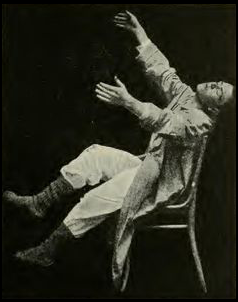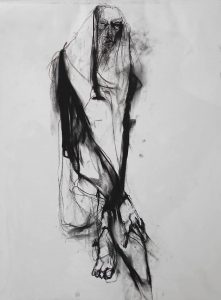Sick & Weak (Upd: Jan 24, ’23)
“Butoh does not intend to scandalize but rather to show compassion for these frightful sufferers and to connect with them as definitive parts of our universe.” – Juliette T. Crump¹
Due to Tatsumi Hijikata, the sick or debilitated body is a major butoh motif. If you have worked with the sick before such as myself,* you likely have the capability of possessing deep sick body resonance.
Through this sick resonance, we can show the shadow of self and the world in compassion. Both Grotowsky and Artaud held this ideal, and Artaud (like Hijikata) may have become its martyr. Shomit Mitter elaborated when saying: “[Like] that of scapegoat, so too for Grotowski, Artaud had to ‘take society’s sickness into himself’ in order to purify the community through his release.”7 Butoh hence can lend itself to shadow work and psychodrama.
World of The Neurology Ward — Hijikata’s list of sick in the head butoh-fu.
Example Characters
1. The Sick Man Experiencing Crown Chakra Bliss
2. The Contracted Sick Woman Holding the Last String of Life In-between Her Tightly Twisting Ball of Hands
3. Snoop Dogg post-lobotomy or Snoop Lion Who Changes His Name to Snoop Dyin’
Tatsumi Hijikata’s Flamen
Physical Illness
Or more lightly put, the “differently abled.” Be keen to any form of physical illness or debilitation. Promising sicknesses to explore that may exhibit intriguing movement and theater: (1) narcolepsy; (2) Tourettes; (3) muscular distrophy; (4) stroke; (5) epilepsy.
Mental Illness
Or more lightly put, the “mentally unique.” We can also explore mental illnesses such as: (1) Drug addiction/withdrawal; (2) Schizophrenia; (3) Kleptomania; (4) Dementia (Alzheimer’s); (5) Anxiety disorder (panic attacks); (6) Personality disorder; (7) Hypochondria; (8) Sexual disorder (e.g. voyeurism, fetishism).
(Dis)ability Paradox
Hijikata’s famous quote “Butoh is a corpse standing straight up in a desperate bid for life,”9 connects the furthest thing one would usually think of as dancing (a corpse) to dancing. This is an example of yet another of the many paradoxes associated with butoh. When both ability and disability merge, we have the qualia of what I call the achilles zeal, the durruble, and impotant.
Common Psychiatric Issues

Schizophrenia
“The name of ‘madman’ with which it is attempted to gag all innovators should be looked upon as a title of honour.” – Umbro Apollonio (Technical Manifesto of Futurist Painting, 1910)8
Schizophrenia is the archetypal illness of insanity and a potent qualia for butoh. It is characterized by hallucinations (all senses) and delusions. Other characterizations involve disorganized speech (schizophrenese, incoherent or paradoxical), catatonic behavior, and negative symptoms such as emotional flattening, alogia (lack of speech), or avolition (loss of motivation). In history, it has been associated with demonic possession.²
Delusions of Control
These are delusions where one’s actions, thoughts, or emotions are thought to come from an external source and not actually from themselves. For instance: “It is my hand and arm that move, and my fingers pick up the pen, but I don’t control them. What they do is nothing to do with me.”³
The same idea can be found with the anarchic hand sign (AHS) delusion of control. The anarchic hand seems to have a mind of its own, opens doors, or scribbles on paper. Those with this affliction are not approving of such action and will claim the hand does not do what he/she/they wants it to do.³
Such a state is one that Tatsumi Hijikata encouraged his dancers to enter into. He once stated, “Even your own arms, deep inside your body feel foreign to you, feel that they do not belong to you. Here lies an important secret. Butoh’s radical essence is hidden here.”
Catatonic Schizophrenia
Catatonic Schizophrenia is a sub-type of schizophrenia heavily affecting the motor function. The illness contains the following symptoms.4 They are all listed with example butoh applications.
Stupor: decreased reaction or spontaneous movement (example relation: ash walk, stone walk.)
Excitement: Purposeless motor activity such as repetition (example relation: filler, idle & scribble.)
Posturing & Rigidity: Inappropriate posturing and/or stiffness (example relation: statue & freeze)
Flexibility: Twisting or out of place body parts (example relation: extremity rotation).
Negativism: Resistance to all instruction and/or being moved (example relation: rejecting thrown qualias).
Facial Expression: Inappropriate facial expression to the context, e.g. large grin (example relation: deterritorialized face, floor face)
Other: gesture or speech imitation, command automatism, weak will (example relation: deterritorialized sound, mirroring).
Personality “Disorders”
We can draw inspiration and build characters out of unaccepted or marginalized behaviors in society. This is not to say that these behaviors are truly “bad” or “unacceptable” but that this is the way modern western civilization views them or at the very least a select privileged, academic few.
In other words, these are the shadows of modern civilization. I prefer to view these classifications as “misunderstood.” Anybody who has them are, to me, “mentally unique” instead of “crazy,” “mentally sick” or “maladjusted.” One behavior at one side of the planet may be viewed completely different at another side. Besides, if we were to clean the slate completely of all these “disorders,” perhaps that would create a perfectly crafted zombie. Ask your doctor if this numbness is right for you.
Nonetheless, here is a list of 3 cluster groups and the 10 personality “disorders” identified by the Diagnostic and Statistical Manual of Mental Disorders (DSM-5).5
The personalities are broken up into three clusters.
1. Cluster A
Viewed as strange, odd, bizarre, eccentric, and include the paranoid, schizoid, and schizotypal “disorders.”
2. Cluster B
Viewed as dramatic or erratic and include the antisocial, borderline, histrionic, and narcissistic “disorders.”
3. Cluster C
Viewed as anxious or fearful and include the avoidant, dependent, and obsessive-compulsive “disorders.”
And the ten personality disorders are paranoid, schizoid, schizotypical, antisocial, borderline, histrionic, narcissistic, avoidant, dependent, and obsessive-compulsive.6
View the details about these disorders here.
